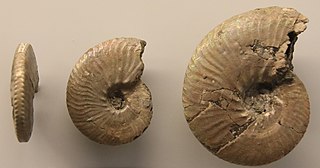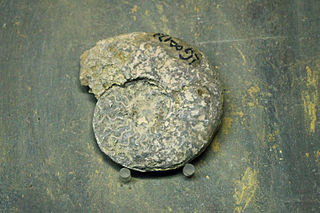
Ammonoceratites is an extinct genus of ammonoid cephalopod known from the Albian of British Columbia, Madagascar, New Zealand, and Japan, included in the Lytoceratidae.

Anahoplites is a genus of rather involute, compressed hoplitid ammonites with flat sides, narrow flat or grooved venters, and flexious ribs or striae arising from weak umbilicle tubercles that end in fine dense ventrolateral nodes. The elements of their sutures are short, wide and jaggedy. Specimens of Annahoplites have diameters typically in the range of 4–6 centimetres (1.6–2.4 in) although some with diameters of as much as 19 centimetres (7.5 in) have been reported. The genus lived during the Cretaceous, from the Middle to the late Albian.
Balearites is an extinct ancyloceratin genus included in the family Crioceratitidae, subclass Ammonoidea, from the Upper Hauterivian.

Barremites is an ammonoid cephalopod genus belonging to the family Desmoceratidae, that lived during the Hauterivian and Barremian stages of the Early Cretaceous.
Dobrogeites is a genus of ammonoids from the order Ceratitida, included in the family Megaphyllitidae that produced evolute compressed planispiral shells with rounded venters, inner whorls ornamented as in Tirolites, outer whorls smooth, suture with multiple smooth lobes; Initially found in Anisian sediments in Romania.

Ceratitida is an order that contains almost all ammonoid cephalopod genera from the Triassic as well as ancestral forms from the Upper Permian, the exception being the phylloceratids which gave rise to the great diversity of post-Triassic ammonites.
Paraceltitidae is a family of Middle and Upper Permian cephalopods, that comprise the earliest of the Ceratitida. Paraceltitidids have variably ribbed, discoidally evolute shells with compressed elliptical whorl sections and simple suture lines. Their origin is most likely in the Daraelitidae of the Prolecanitida and they are the apparent source of the Xenodiscidae. All together they lived for some 12 million years, from about 270.6 to about 258 million years ago.
The Ophiceratidae is a family in the ammonoid order Ceratitida from the Lower Triassic, previously included in the Otocerataceae but now placed in the Noritiaceae as revised.

Stephanoceratoidea, formerly Stephanocerataceae, is a superfamily of middle- upper Jurassic ammonoid cephalopods within the order Ammonitida containing diverse forms, generally with sharp ribbing and complex suture lines. Aptychi are believed to be mostly granular (Granulaptycus) or concentrically ribbed on the surface (Praestriaptychus)
Ptychitoidea, formerly Ptychitacheae, is a superfamily of typically involute, subglobular to discoidal Ceratitida in which the shell is smooth with lateral folds or striations, inner whorls are globose, and the suture is commonly ammonitic. Their range is Middle_ and Upper Triassic.
Pachyceratidae is a family of Perisphinctoidean ammonites from the upper Middle - and lower Upper Jurassic. Genera within the Pachyceratidae have shells that are in general moderately involte but with most of the inner whorls exposed; whorl sections subquadrate to subtrapezoidal, with rounded venter. Ribbing is strong, in some sharp. Primary ribs typically branch above mid flanks into twos, threes, and even fours.

Gymnites is a genus of ammonoid cephalopod from the Middle Triassic belonging to the ceratitid family Gymnitidae. These nektonic carnivores lived during the Triassic period, the Anisian age.
The Crioceratidae constitute a family of loosely to closely coiled Ammonitida included in the Ancyloceratoidea that lived during the Early Cretaceous; characterized by Crioceratites and other genera such as Hoplocrioceras and Paracrioceras.

Neocomitidae is a family of Lower Cretaceous ammonitids comprising genera with strongly ribbed evolute to smooth, fairly involute shells.
Pseudohaploceras is a genus of desmosceratid ammonites from the Early Cretaceous; Valanginian to Albian epochs.

Flemingites is an extinct genus of evolute ammonoid from the Smithian with spiral ridges on the shell.
Sturia is a genus of ceratitid ammonoids from the Lower Triassic with an ammonitic suture.
Euomphaloceratinae is a subfamily of Upper Cretaceous ammonites included in the Acanthoceratidae, characterized by generally evolute shells with quadrate whorl sections that are strongly ribbed. Sutures are ammonitic, but not overly complex.

Hammatoceratidae is a family of lower and middle Jurassic ammonites included in the superfamily Hildoceratoidea.

Hammatoceras is a genus of ammonites belonging to the family Hammatoceratidae which lived during the Toarcian stage of the Early/Lower Jurassic between about 184 and 175 million year ago.
W.J Arkell, et al. 1957. Mesozoic Ammonoidea; Treatise on Invertebrate Paleontology, Part L. Geological Society of America and University of Kansas Press.









